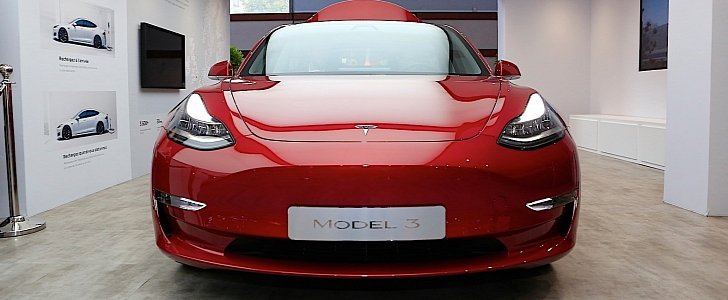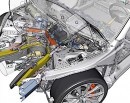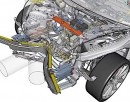Undoubtedly, these last few months of the year have been Tesla Model 3's fifteen minutes of fame.
First, the car seems to be breaking record after record when it comes to sales. Then, its production and delivery issues appear to have winded down. And last, but not least, the European launch is just around the corner.
Over the past two weeks, the Model 3’s crash tests ratings were released, along with a company safety report (that also covers Model X and S). And the numbers are all shiny and glamorous.
First of all, according to the safety report released by Tesla, crashes involving its models usually don’t happen.
As per NHTSA data, cars of all makes typically get crashed once every 492,000 miles. Teslas seem to be doing much, much better.
Tesla cars are connected, which means the company has instant access to the vehicles’ data. So it kinda of can say precisely how many miles its cars drive before being involved in a crash, when and so on.
Data collected so far shows that in the third quarter of 2018, Tesla cars crashed once in 1.92 million miles. And that when humans were in control, as when the Autopilot was engaged, this average rockets to one crash in 3.34 million miles.
Of course, at the beginning of the year, various Tesla cars were involved in crashes blamed, at least at first, on the Autopilot.
But with a direct link yet to be established, and with the numbers now available from Tesla, one can assume the Autopilot does what it was meant to do.
As a side note, In October the system received an update meant, among other things, to make it safer than ever.
But the Model 3 is a car, so crashes do occur. When this happens, the Model 3 was found to protect its occupants well enough for the NHTSA to give it a five-star rating in frontal, side and rollover crash test.
Tesla says this was possible thanks to the fact that the Model 3 has a weight distribution of 50/50. It has been designed so that the heaviest parts are located closer to the car’s center of gravity, making it very stable: the battery pack sits right down the middle of the car, while the rear motor is placed slightly in front of the rear axle rather than behind it.
This in effect makes the car perform just as a mid-engined vehicle - even though it has no engine – improving stability and control. Combined with the front crumple zone and a rigid battery compartment, this layout also helps to distribute crash forces away from the cabin.
What's more interesting is that Tesla claims the Model 3 has been found to pose the lowest risk of injury to its drivers of all the cars the NHTSA ever tested.
As per the figures provided by the carmaker, in case of a crash the probability of injury in a Model 3 is around 5 percent. For most other cars, that percentage sits at somewhere above 6 and even seven percent.
After learning of Tesla's claims, the NHTSA said in a statement there is no such thing as “safest car ever tested.”
“NHTSA does not distinguish safety performance beyond the star rating with five stars being the highest safety rating a vehicle can achieve. Thus, there is no NHTSA ‘safest’ ranking within the five-star category,” the agency said according to Reuters.
In the first months of next year, the Model 3 will reach Europe. Traditionally, the Old Continent is considered to be less dangerous than North America when it comes to driving, so it's likely the numbers Tesla will be submitting in its safety reports in the future will be even more glamorous.
We'll have to wait and see in the Euro NCAP agrees with the NHTSA and the carmaker, should Tesla choose to have the Model 3 crash tested in Europe as well.
Over the past two weeks, the Model 3’s crash tests ratings were released, along with a company safety report (that also covers Model X and S). And the numbers are all shiny and glamorous.
First of all, according to the safety report released by Tesla, crashes involving its models usually don’t happen.
As per NHTSA data, cars of all makes typically get crashed once every 492,000 miles. Teslas seem to be doing much, much better.
Tesla cars are connected, which means the company has instant access to the vehicles’ data. So it kinda of can say precisely how many miles its cars drive before being involved in a crash, when and so on.
Data collected so far shows that in the third quarter of 2018, Tesla cars crashed once in 1.92 million miles. And that when humans were in control, as when the Autopilot was engaged, this average rockets to one crash in 3.34 million miles.
Of course, at the beginning of the year, various Tesla cars were involved in crashes blamed, at least at first, on the Autopilot.
But with a direct link yet to be established, and with the numbers now available from Tesla, one can assume the Autopilot does what it was meant to do.
As a side note, In October the system received an update meant, among other things, to make it safer than ever.
But the Model 3 is a car, so crashes do occur. When this happens, the Model 3 was found to protect its occupants well enough for the NHTSA to give it a five-star rating in frontal, side and rollover crash test.
Tesla says this was possible thanks to the fact that the Model 3 has a weight distribution of 50/50. It has been designed so that the heaviest parts are located closer to the car’s center of gravity, making it very stable: the battery pack sits right down the middle of the car, while the rear motor is placed slightly in front of the rear axle rather than behind it.
This in effect makes the car perform just as a mid-engined vehicle - even though it has no engine – improving stability and control. Combined with the front crumple zone and a rigid battery compartment, this layout also helps to distribute crash forces away from the cabin.
What's more interesting is that Tesla claims the Model 3 has been found to pose the lowest risk of injury to its drivers of all the cars the NHTSA ever tested.
As per the figures provided by the carmaker, in case of a crash the probability of injury in a Model 3 is around 5 percent. For most other cars, that percentage sits at somewhere above 6 and even seven percent.
After learning of Tesla's claims, the NHTSA said in a statement there is no such thing as “safest car ever tested.”
“NHTSA does not distinguish safety performance beyond the star rating with five stars being the highest safety rating a vehicle can achieve. Thus, there is no NHTSA ‘safest’ ranking within the five-star category,” the agency said according to Reuters.
In the first months of next year, the Model 3 will reach Europe. Traditionally, the Old Continent is considered to be less dangerous than North America when it comes to driving, so it's likely the numbers Tesla will be submitting in its safety reports in the future will be even more glamorous.
We'll have to wait and see in the Euro NCAP agrees with the NHTSA and the carmaker, should Tesla choose to have the Model 3 crash tested in Europe as well.







